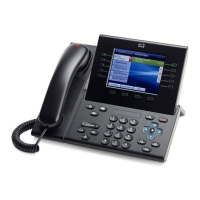1-11
Cisco Unified IP Phone 8961, 9951, and 9971 Administration Guide for Cisco Unified Communications Manager 8.5 (SIP)
OL-20861-01
Chapter 1 An Overview of the Cisco Unified IP Phone
What Networking Protocols are Used?
Hypertext Transfer
Protocol (HTTP)
HTTP is the standard way of transferring
information and moving documents across
the Internet and the web.
Cisco Unified IP Phones use HTTP for the XML
services and for troubleshooting purposes
Hypertext Transfer
Protocol Secure (HTTPS)
Hypertext Transfer Protocol Secure
(HTTPS) is a combination of the
Hypertext Transfer Protocol with the
SSL/TLS protocol to provide encryption
and secure identification of servers.
Web applications with both HTTP and HTTPS
support have two URLs configured. Cisco Unified
IP Phones that support HTTPS choose the HTTPS
URL.
IEEE 802.1X The IEEE 802.1X standard defines a
client-server-based access control and
authentication protocol that restricts
unauthorized clients from connecting to a
LAN through publicly accessible ports.
Until the client is authenticated, 802.1X
access control allows only Extensible
Authentication Protocol over LAN
(EAPOL) traffic through the port to which
the client is connected. After
authentication is successful, normal traffic
can pass through the port.
The Cisco Unified IP Phone implements the IEEE
802.1X standard by providing support for the
following authentication methods: EAP-FAST,
EAP-TLS, and EAP-MD5.
When 802.1X authentication is enabled on the
phone, you should disable the PC port and voice
VLAN. Refer to the “Supporting 802.1X
Authentication on Cisco Unified IP Phones” section
on page 1-22 for additional information.
IEEE 802.11a/b/g The IEEE 802.11 standard specifies how
devices communication over a wireless
local area network (WLAN).
802.11a operates at the 5 GHz band and
802.11b and 802.11g operate at the 2.4
GHz band
(Cisco Unified IP Phone 9971 only) The 802.11
interface is a deployment option for cases when
Ethernet cabling is unavailable or undesirable.
Internet Protocol (IP) IP is a messaging protocol that addresses
and sends packets across the network.
To communicate using IP, network devices must
have an assigned IP address, subnet, and gateway.
IP addresses, subnets, and gateways identifications
are automatically assigned if you are using the
Cisco Unified IP Phone with Dynamic Host
Configuration Protocol (DHCP). If you are not
using DHCP, you must manually assign these
properties to each phone locally.
Link Layer Discovery
Protocol (LLDP)
LLDP is a standardized network discovery
protocol (similar to CDP) that is supported
on some Cisco and third-party devices.
The Cisco Unified IP Phone supports LLDP on the
PC port.
Table 1-4 Supported Networking Protocols on the Cisco Unified IP Phone (continued)
Networking Protocol Purpose Usage Notes

